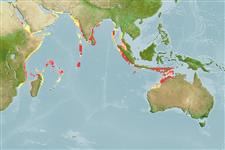>
Ovalentaria/misc (Various families in series Ovalentaria) >
Pomacentridae (Damselfishes) > Chrominae
Etymology: Chromis: Greek, chromis = a fish, perhaps a perch (Ref. 45335); xouthos: Name from Greek 'xouthos' meaning yellowish-brown; refers to the overall coloration..
Environment: milieu / climate zone / depth range / distribution range
Ekologi
laut berasosiasi dengan karang; kisaran kedalaman 12 - 50 m (Ref. 90102). Tropical
Indian Ocean: Maldive Islands and Chagos Archipelago to off the Andaman Sea coast of Thailand; and Indonesia; probably Andaman and Nicobar Islands, and Mergui Archipelago, off Myanmar.
Size / Weight / umur
Maturity: Lm ? range ? - ? cm
Max length : 9.2 cm SL jantan/; (Ref. 75747)
deskripsi pendek
Morfologi | Morfometrik
Duri punggung (Keseluruhan (total)): 13; duri punggung lunak (Keseluruhan (total)): 12; Duri dubur 2; Sirip dubur lunak: 11 - 12; vertebrata, bertulang belakang: 26. This species is distinguished by the following characters: DXIII,12; A II,11 (rarely 12); pectoral rays 19 (rarely 18); spiniform caudal rays 3; tubed lateral line scales 16-17; gill rakers 6-7 + 19-21 (total, 26-28); body depth 1.9-2.0 in SL; colour when alive is mainly golden brown with yellowish caudal fin and pale bluish-grey pelvic fins (Ref. 75747).
This species is usually encountered in clear water over coral reefs at depths between about 12 and at least 45 m. Habitats include both gradually sloping bottoms and steeper drop-offs, but in the former case it was restricted to depths greater than 20 m in the vicinity of isolated, small patch reefs. Generally, this species forms aggregations ranging from just a few fish to at least 20-30 individuals, feeding on plankton up to several meters above the bottom. The fish retreat to caves, crevices, and ledges when approached closely by divers (Ref. 75747). Life history characteristics for the family specify that this species is oviparous, with distinct pairing during breeding (Ref. 205). Eggs are demersal and adhere to the substrate (Ref. 205). Males guard and aerate the eggs (Ref. 205).
Life cycle and mating behavior
Kematangan | Reproduksi, perkembang biakan | Pemijahan | telur-telur | Fecundity | Larva
Life history characteristics for the family specify that this group is oviparous, with distinct pairing during breeding (Ref. 205). Eggs are demersal and adhere to the substrate (Ref. 205). Males guard and aerate the eggs (Ref. 205).
Allen, G.R. and M.V. Erdmann, 2005. Chromis xouthos, a new species of damselfish (Pomacentridae) from the East Andaman Sea and Central Indian Ocean. aqua, J. Ichthyol. Aquat. Biol. 10(3):89-94. (Ref. 75747)
Status IUCN Red List (Ref. 130435)
ancaman kepada manusia
Harmless
penggunaan manusia
informasi lanjut
Umur / SaizPertumbuhanpanjang-beratpanjang-panjangukuran frekuensiMorfometrikMorfologiLarvaDinamika larvapemulihanKelimpahanBRUVS
AcuanBudidaya airprofil budidaya airStrainGenetikaElectrophoresesDiturunkanPenyakit-penyakitPengolahanNutrientsMass conversion
mitraGambarStamps, Coins Misc.Suara-suaraCiguateraKecepatanTipe renangArea insangOtolithsOtakPenglihatan / visi
Alat, peralatan
laporan khas
muat turun XML
Sumber internet
Estimates based on models
Preferred temperature (Ref.
123201): 27.8 - 29, mean 28.4 °C (based on 30 cells).
Phylogenetic diversity index (Ref.
82804): PD
50 = 0.5000 [Uniqueness, from 0.5 = low to 2.0 = high].
Bayesian length-weight: a=0.01778 (0.00796 - 0.03971), b=2.99 (2.81 - 3.17), in cm total length, based on LWR estimates for this Genus-body shape (Ref.
93245).
Trophic level (Ref.
69278): 3.0 ±0.1 se; based on size and trophs of closest relatives
Daya lenting (Ref.
120179): Tinggi, Waktu penggandaan populasi minimum kurang dari 15 bulan (Preliminary K or Fecundity.).
Fishing Vulnerability (Ref.
59153): Low vulnerability (10 of 100).
